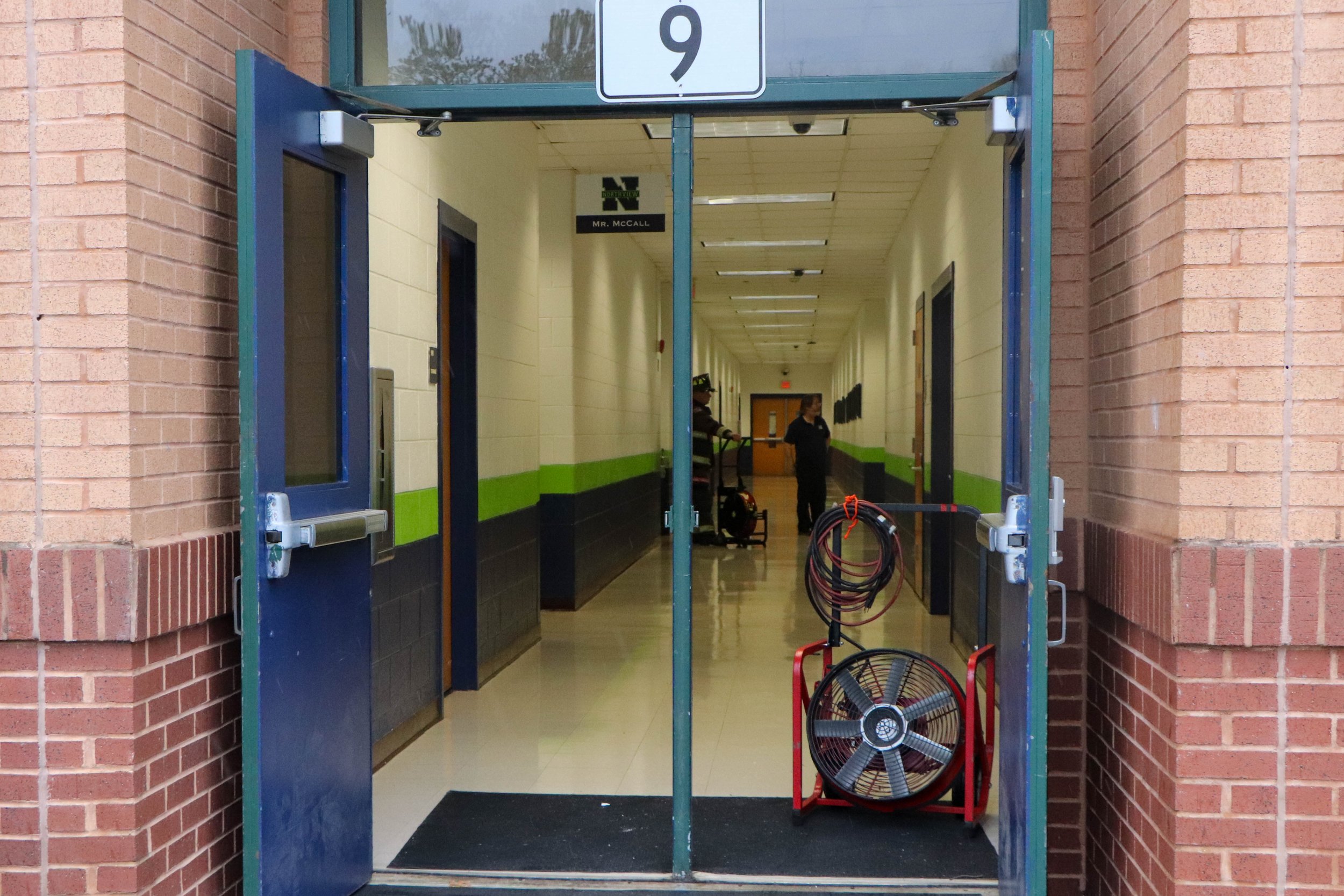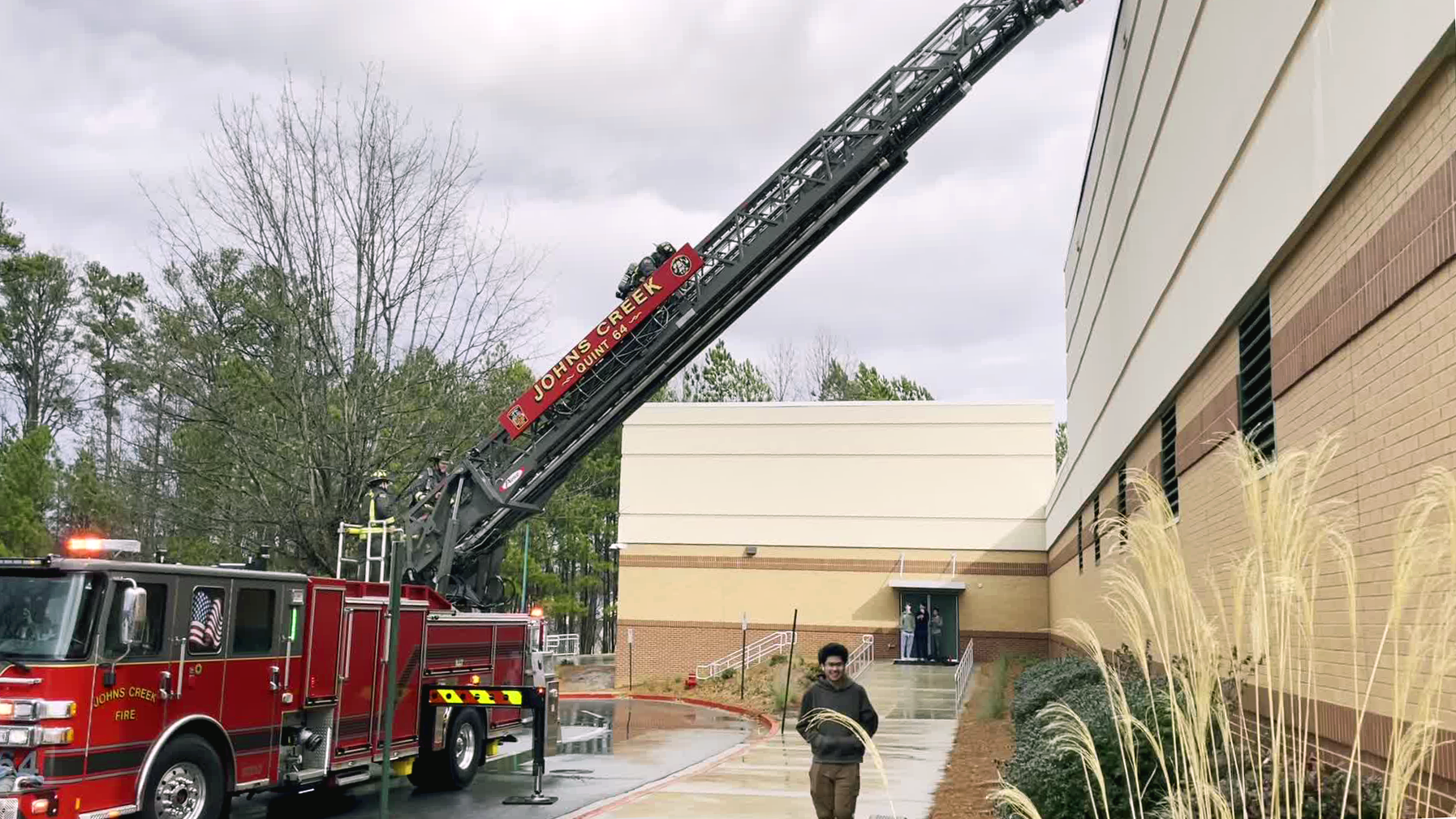Fire alarms send students into freezing downpour
Evacuations interrupt classes ahead of long weekend
Photo by Milly Miao, Managing/Multimedia Editor
Sydney Mulford, Editor-in-chief, Kevin Xiang, Editor-in-chief, & Milly Miao, Managing/Multimedia Editor
Additional interviewing help: Katelyn Wu, News Editor, Anya Biswas, Feature Editor, & Nethra Pai, Staff Writer
This morning, two separate fire alarms, caused by a water pressure pipe issue and an air conditioning unit failure, interrupted classes, causing students and teachers to evacuate. Classes waited outside for an hour as fire officials located the problems.
The first alarm went off roughly 10 minutes into third period, around 11 a.m. An alarm panel registered a water pressure drop, a possible sign of a sprinkler flooding a room to quell a fire.
“We don’t know why there was low water pressure,” Northview Principal, Martin Neuhaus said. “We’re trying to investigate that.”
This alarm also set off the intercom, telling students and faculty to evacuate the building, but students quickly reentered the building after administrators could not find any issue.
However when the alarm was triggered, Northview’s Heating, Ventilation, and Air Conditioning (HVAC) systems shut off, a precaution to avoid feeding oxygen into possible fires. When the HVAC units restarted following the first alarm, one on top of the P.E. hallway malfunctioned.
Fireman waiting in the hallway where the smoke originated from. Photo by Milly Miao, Managing/Multimedia Editor
A rubber belt powering a fan burned out, sending smoke into the visitor’s locker room. This triggered the alarms for a second time. After an initial announcement instructing students to remain in class, administration prompted everyone to evacuate the building, again.
“I was confused at first. When we went out again, it was really weird,” sophomore Ayush Patwari said. “We didn’t know if it [was] a drill or not.”
For some students, the fire alarm interrupted the numerous tests and quizzes they had the day before a long weekend.
“I thought they were lying because I was taking a physics test,” junior Jane Kwak said. “Everyone was just sitting there trying to answer more questions.”
About ten minutes after the second alarm, a slight drizzle turned into a downpour. This prompted students to hide under the front office awning and the bus canopy. Where those protections were not available, such as the gym entrance, students hid under trees, jackets, and umbrellas.
Students crowd in front of the school after the second alarm goes off. Photo by Shadi Karimifard, Staff Writer
“I was mad because it was cold, and I didn’t like it,” sophomore Dristi Dave said. “I just wanted to leave.”
A portion of students also ran to warmth and safety inside their cars, with some even leaving the campus.
“We're not going to physically stop [students] from leaving,” Neuhaus said. “I understand ‘I’m cold, wet, and I have my own car.’ We just want everyone to be safe.”
Northview practices drills throughout the year so students, faculty, and teachers know what to do in case of an emergency like today. But, drills are traditionally done in optimal weather conditions–not the pouring rain.
In light of the conditions, the administration also asked to get students back in the building during the incident, in areas away from the gym. However, the fire department denied the request.
“[The] fire department’s not too worried about you being cold or wet because their number one job is to make sure you're safe,” Neuhaus said.
Working to secure the malfunctioning HVAC unit was the fire department’s main priority.
“We had some units go inside to investigate. They found smoke in the visitor’s locker room,” Battalion Chief Anthony Saunders said. “We were able to isolate that unit and kill the power to it.”
The fire department went through an extensive process to contain the smoke. The room where the HVAC unit was causing the smoke had a sheetrock ceiling, which is harder to access compared to Northview’s usual drop ceilings. After cutting through and finding the shutoff inaccessible, the fire department accessed the unit from the roof.
Firemen climbs up the ladder to reach the roof to access the HVAC unit. Photo by Kevin Xiang, Editor-in-chief
When the fire department secured the building and announced everyone could return back into the building, it took a little while for the news to spread around the campus. Administrator Marisa DiSano quickly instructed students to stay in their third period classroom and for students in P.E. to go to the cafeteria or media center until further instruction. However, the ovens were shut off and cafeteria workers were not in the building during the evacuation, so there was no food ready for students to eat. Administration rushed to figure out what the schedule for the rest of the day would look like while cafeteria workers finished making lunch.
“We were able to [finish A lunch in] about 30-35 minutes, and [B lunch] was a little faster because it's a little smaller,” Neuhaus said. “Once we saw that the line was done, we said ‘let's just announce five more minutes to finish eating.’ We were just five to 10 minutes from being back on schedule.”
Fifth period was roughly five minutes shorter, whereas, sixth period was the normal length.
“I’m really proud of the students, and really the staff too, for sticking to it,” Neuhaus said. “We got wet, we were cold or a little miserable, but we were safe, and we did get to resume teaching and learning.”
Fulton County has already slated the aging HVAC systems for replacement. This will take place over the next few summers.
“I can't say that that's never going to happen again,” Neuhaus said. “But I can tell you, we've been through in a pretty bad situation. If it happens again, it'll probably won't be as bad unless it's raining [even] worse.”





